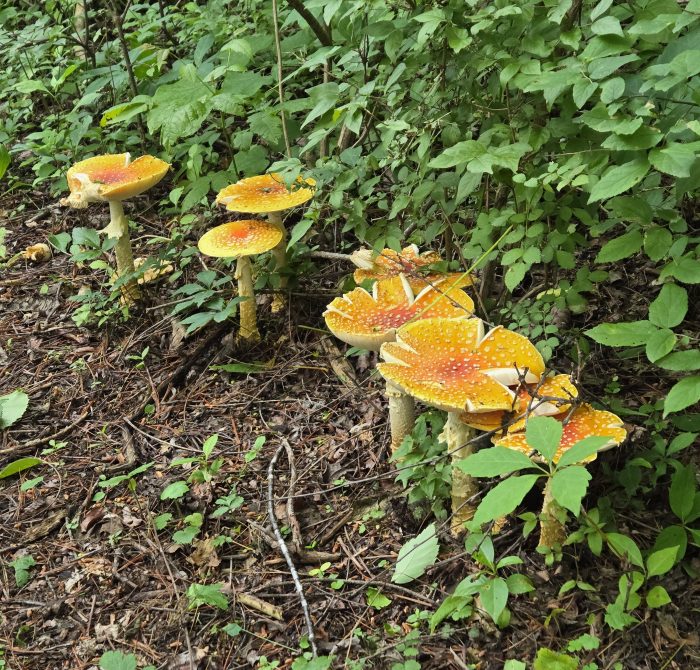- Daleville, VA (730.6) to the Wilson Creek shelter (741.8)
- 3241 feet rise, 2635 feet decrease
Today was a bright day full of energy inside and around us. After rainy days, the air was clear, the wind was fresh and moderate temperatures. Bugs, reptiles, plants, and we all leave our protected places to enjoy the sun.
Although we stopped again and again to take photos and delight with the details of the world, we cover more miles, we upload more hills and expand more descents than usual in our 9 hours of hiking.
A beginning as a park
Daleville’s first miles are a mixture of urban forests and parks. Exploited by the undulating and recently cut grass were hundreds of Lowe construction flags in a variety of colors.
At first, we assumed that they would mark the underground cables. Then, after one more or less mile, we detected a pattern to mark several plants that could identify as native value plants. The flags suggested that someone was spending a lot of time eliminating the harmful native species and protecting.
Lunch at Fullhardt Knob Shelter
Our original plan for yesterday had been to do tasks at Daleville and sleep in Fullhardt Knob Shelter last night. Instead, after zoom along 5.6 miles in just 3 1/2 hours this morning, we had early in Fullhardt Knob.
We enjoyed heavy bars and an apple that we had taken out of the city. We complement each other in our hiking skill. We had promoted 1798 and we descended 423 feet on our morning of 5 1/2 miles.
A fresh breeze
Part of the reason we walked so well today was the weather. We love the coolest climate. Today we had a fresh breeze.
We find a fresh breeze 29-38 kph (19-24 mph) vigorizing. More than that can be exhausting since things fly in the air and trekking posts fly sideways. A few times during the day we contend with higher winds. However, above all, with temperatures in the 60s and our fresh breeze, we delight in what we call «walking air.»
Mushrooms and moss
Throughout the day, we noticed how busy the world was around us. It was almost as if all living creatures were putting their heads, stretching and yawning after weeks of being exhausted from rainy storms.
There were many fungi. Without knowing much about wild fungi, we admire them but we never feed them. This beautiful exhibition seems to be from Amanita cluster. If that is true, although they only represent a small percentage of all fungi, they represent 90% of fungal poisoning. We admire them and move on.


Even mosses were special. For hundreds of yards along the path, there was an exhibition of mixed peat sphagnaceae and reider moss leuucobryum glaucum. The reindeer moss was soft and green of recent rains.

Arachnids and reptiles
Buried on the ground cover, I saw a black caramel spider Sphodros Niger.

Later, a box turtle was sitting right in the middle of the path, enjoying the sun.

The frogs have announced their presence on our trip, but generally with their voices. Today a chubby Fowlers Sapo Anaxyrus Fowleri I went up with us for a while before deciding a walk it was not for him.

Although we have seen many red effects and their adult brothers, we find a salamand of a variety that we have never seen. I think it’s a dark salamander from the Allegheny mountain
Desmognathus ochrophaeus.
A small reading suggests that it is not a rare species, but given its dark color, perhaps for an unreasonable eye, it looks less frequently. Today’s light may have helped us see her today.

Among our Friends of the Forest today was a caterpillar that was heading to a butterfly. This seems to be a Red Admiral butterfly in the third or fourth stage Vanessa Atalanta Rubria Imadura

The end of a good day
After a day of endless detailed sightings, we arrived at the Wilson Creek shelter around 6:30. It takes us about 2 hours to establish the camp, eat and retire.
When we arrive at the camp, the historian uses a small electric pump to inflate our two sleeping pads. Then add our mats and sheets. Begin food tasks. Food tasks include re -beating our dinner, preparing breakfast and classifying snacks, and lunch for the next day.
In general, the historian is our water collector and filter. We hang or support our food, since two are needed to work more easily.
Tonight, we have red and rice beans, one of our favorite dinners, at home and on the way.

After dinner, the historian begins his most important task: to recharge his body for tomorrow lying down and immediately falling asleep. I close my day taking notes in my diary and reading for a few minutes before starting my recharge cycle. Tonight, with the historian snoring gently by my side, I savor all the details of the day. I keep them in my heart and I also fall asleep peacefully.
This website contains affiliate links, which means that the walk can receive a percentage of any product or service that you buy using the links in the items or ads. The buyer pays the same price that would do it differently, and his purchase helps to support the continuous objective of the walk to address his quality backpack advice and information. Thanks for your support!
For more information, visit the page about this site.




:max_bytes(150000):strip_icc():focal(718x584:720x586)/Miss-Universe-competition-053124-1-bd3d61936e0341e994b5ac43ae5453d6.jpg?w=238&resize=238,178&ssl=1)